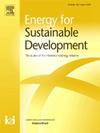Ranking the risks of India's coal phase-down: An analytical hierarchy process approach
IF 4.9
2区 工程技术
Q2 ENERGY & FUELS
引用次数: 0
Abstract
Phasing down coal is critical to addressing climate change. However, the deep entrenchment of coal in India's techno-economic and socio-political landscape entails severe risks. Coal currently supplies 55 % of India's primary commercial energy, generates nearly 70 % of electricity and sustains around 13 million jobs directly and indirectly. Notwithstanding these dependencies, existing research on coal phase-down in India has primarily focused on its incentives and benefits, specifically using techno-economic assessments. A critical gap lies in systematically analysing the risk associated with coal phase-down, particularly from the perspective of energy justice and policy design. This study examines the major risks of coal phase-down in India and ranks them based on severity using the Analytical Hierarchy Process (AHP) and expert interviews. To accomplish this, the six major risks of coal phase-down in India were examined and ranked based on five criteria: economic, social, technological, political, and climate. The findings reveal that ‘loss of livelihoods’ is the most severe risk, followed by ‘threats to energy security’ and ‘loss of government revenue’. Though ‘technological complexity’, ‘rising import dependency’, and ‘creation of stranded assets’, emerged as significant risks, they were ranked lower in severity. Theoretically, this study contributes to energy transition scholarship by demonstrating the application of multi-criteria decision-making approaches in risk analysis, offering a replicable framework for assessing transition risks in coal-dependent economies across the Global South. Practically, it equips policymakers with a structured framework to anticipate, prioritise and mitigate transition risks, thereby informing the design of equitable and resilient phase-down strategies.
印度淘汰煤炭的风险排名:一种层次分析法
逐步减少使用煤炭对应对气候变化至关重要。然而,煤炭在印度技术经济和社会政治领域的根深蒂固的地位带来了严重的风险。煤炭目前提供了印度55%的主要商业能源,产生了近70%的电力,并直接和间接地维持了约1300万个就业岗位。尽管存在这些依赖关系,但目前关于印度逐步减少煤炭的研究主要集中在其激励和效益上,特别是使用技术经济评估。一个关键的差距在于系统地分析与煤炭逐步减少有关的风险,特别是从能源正义和政策设计的角度。本研究考察了印度煤炭逐步淘汰的主要风险,并使用层次分析法(AHP)和专家访谈对其严重性进行了排名。为了实现这一目标,我们根据经济、社会、技术、政治和气候五个标准,对印度逐步淘汰煤炭的六大风险进行了研究和排名。调查结果显示,“失去生计”是最严重的风险,其次是“对能源安全的威胁”和“政府收入的损失”。尽管“技术复杂性”、“进口依赖度上升”和“搁浅资产的产生”被列为重大风险,但它们在严重程度上的排名较低。从理论上讲,本研究通过展示多标准决策方法在风险分析中的应用,为评估全球南方依赖煤炭的经济体的转型风险提供了一个可复制的框架,从而为能源转型学术做出了贡献。实际上,它为政策制定者提供了一个结构化框架,以预测、优先考虑和减轻转型风险,从而为设计公平和有弹性的逐步减少战略提供信息。
本文章由计算机程序翻译,如有差异,请以英文原文为准。
求助全文
约1分钟内获得全文
求助全文
来源期刊

Energy for Sustainable Development
ENERGY & FUELS-ENERGY & FUELS
CiteScore
8.10
自引率
9.10%
发文量
187
审稿时长
6-12 weeks
期刊介绍:
Published on behalf of the International Energy Initiative, Energy for Sustainable Development is the journal for decision makers, managers, consultants, policy makers, planners and researchers in both government and non-government organizations. It publishes original research and reviews about energy in developing countries, sustainable development, energy resources, technologies, policies and interactions.
 求助内容:
求助内容: 应助结果提醒方式:
应助结果提醒方式:


